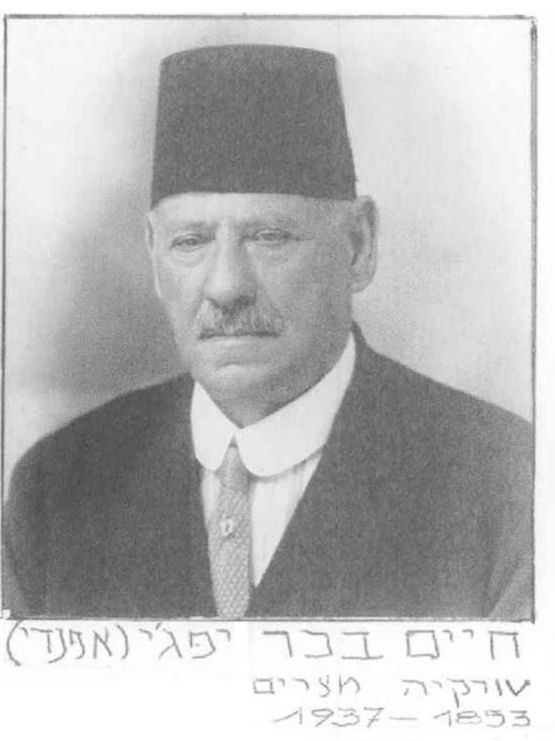15th January 2021 – Shabbat is almost here
And today we’ll listen to a performer and composer who was recorded in 1908 in a production that vies for the honor of being the first commercial Sephardi recording
 Hello, how are you? I hope well. After 52 editions I have never featured this personality, Haim Effendi. He well deserves his turn!
Hello, how are you? I hope well. After 52 editions I have never featured this personality, Haim Effendi. He well deserves his turn!
In an older MBS I shared the recording by Jako el Muzikante of a song that Effendi also recorded, La Mintira de la Muerte. Find it here. Jako is one of the very few current artists that make me feel something near to what I feel with these old recordings, don’t miss him! But in this edition we will listen to a song that is nowadays a “standard” of the Sephardic repertoire: A La Una Nasi Yo, or Las Horas de la Vida.
This song is very, very interesting, because it is very popular in the repertoire of the currently working artists and it seems quite easy to make a cheesy formulaic version of this song. Effendi’s is mesmerising. This is also a very good example of how even though there are several variations, most of the recordings of the latest decades make the same version, with a phrase in the lyrics that doesn’t really make sense and this is maintained because there has been copied all the time the same alternative. You’ll understand this much better here below with the lyrics.
For this edition my partner and husband Juan Antonio Vázquez has supported me and I want to thank him.
| Share the joy of music and learning with your beloved ones. Share MBS. Thank you in advance. |
| Share this with a friend, right from here |

.
.
Las horas de la vida, the hours of the life
This song is interesting for many reasons. One is the lyrics, for several reasons too. This is the song as sung by Haim Effendi.
The transcription mixes the one in the booklet of Eastern Mediterranean Judeo-Spanish Songs from the EMI Archive Trust (1907-1912) and the book by Edwin Seroussi Ruinas Sonoras de la Modernidad.
| Ah! A la una nací yo, a las dos me bavtizaron, a las tres espusí yo, alma y vida y corazón. A las cuatro me casaron. Me casí con un amor, me casí con un amor, que yo amo. Dimi, niña, dónde vienes, Lo moreno hizo’l Dio, En mi güerta crecen viños, |
At one o’clock I was born, I was baptized at two o’clock, At three o’clock I got engaged *, soul and life and heart. At four o’clock I was married. I married a love, I married a love, that I love. Tell me, girl, where do you come from, The swarthy was created by God In my orchard, vines grow, |
** The translation of this word, deprender, has many to talk about. So see below.
*** Edwin Seroussi, in the mentioned book, writes “de prender”. But in the work From Spain to the Eastern Mediterranean and Back, Seroussi writes it as “deprender” (to learn). “De prender” would make the phrase mean “I will make you caught”. Both make sense…
Deprender or defender or pretender or de prender?
All this is very complicated!
If you are interested in learning more, Edwin Seroussi has made a deep work about this song and about Haim Effendi, for instance in his work From Spain to the Eastern Mediterranean and Back. A Song as a Metaphor of Modern Sephardic Culture (you can download it for free in this link) and he talks widely about Effendi in his recent book Ruinas Sonoras de la Modernidad. I think there is no English version yet. I will just pay attention to a few things.
In the introduction I explained that most of the recordings of the last decades has opted for one alternative for the lyrics. For me, the controversial word is “deprender”. In the recordings of the last decades it is said “defender”. So the stanza would mean:
Tell me, girl, where you come from,
because I want to meet you
and if you don’t have a lover
I will have you defended.
The truth is that I never understood the meaning of that phrase (yo te haré defender, in Spanish, but what is the relationship between that and the fact of not having a lover? Why not to say it more clear, like “I will pretend you” or “I will court you”?) so I had an epiphany when I listened to the recording by Haim Effendi in which I clearly listen “deprender”. That word is rarely used in Spanish but it means to learn and it is recogniced as a Spanish word by RAE.
So, why do they sing now “defender”? As mentioned above, if can also be “de prender”, that also makes more sense than “defender”.
You can thrace the appearance of “defender” for instance in Moshe Attías’ Judeo-Spanish Songbook (Cancionero judeo-español), from 1972, whose informants were people from Thessalonikki before the decade of the 1930s. The lyrics he wrote were:
Dime, niña, dónde vienes,
que te quero conocer,
y si no tienes amante,
yo te haré pretender *,
y si no tienes amante,
yo te haré defender,
yo te haré defender,
alma, vida y corazón.
* I think this variation, pretender, that means to court, has transcended much less to the Sephardic music recordings of the latest decades, even though it makes much more sense, than “defender”.
And the work by Seroussi From Spain to the Eastern Mediterranean and Back, he explains that:
“A few years after the release of the record by Haim Effendi, Captain Manuel Manrique de Lara, searching the Sephardic communities in the Eastern Mediterranean in 1911 on behalf of Menéndez Pidal, reached the shores of Beirut. There he met Miss Lucía Delburgo, aged 25, who transmitted to him an oral version of Las horas de la vida”.
And in that version the word was defender:
Dime ninia onde vienes
Che te chero conocer
I si non tienes amante
Che te quero defender
But, why has it stayed “defender” as the usual word, even though it doesn’t really make much sense? I really don’t know, I just can imagine that there is a referential recording after which there have been copies and copies of copies.
I think the main first source was Joaquín Díaz’s album from 1972 Romanzas y cantigas sefardíes. He learned if from the album Sephardic Songs Sung by Gloria Levy, from 1958. All this is explained by Seroussi in the mentioned work.
Joaquín Díaz is a super recognized artist (not in active for some years) and a disseminator who makes outstanding work with his foundation and his archive. He has made much to disseminate the Sephardic repertoire and he has been the reference for many wonderful things. Nevertheless, I would really appreciate that more currently active artists would work on the real old recordings, now that there are so many available with easy and free access.
A la una yo nací… I Was Born at One, Colombia’s time
This definitely is not Haim Effendi |
The lyrics are so sexist that you don’t want to understand them…
The fact is that the song as by Effendi is composed by cuartetas, a very usual shape for poetry in the Spanish traditional music. The stanzas or couplets are placed one after another just on a whim, both in the song as by Effendi and in the current traditional music in Spain in several styles. The stanzas don’t need to be related. My band Vigüela, of which I am the manager, sing couplets like this one:
The swarthy was created by God
and the white was made by the silversmith.
Long live the swarthy people
that for them I die.
For instance, in this recording of a rondeña (a kind of fandango, that is a style widely spread in Spain and with many variations) the forth couplet is:
| A lo alto de la sierra Lo moreno es lo que vale Lo blanco lo quema el sol Y lo colorado el aire. |
At the top of the mountain range The swarthy is what counts The white is sunburned And the red is burnt by the air. |
Click the picture to listen to the recording by Haim Effendi:
| Share this with a friend, right from here |
Shabbat Shalom.
Araceli Tzigane | Mapamundi Música
